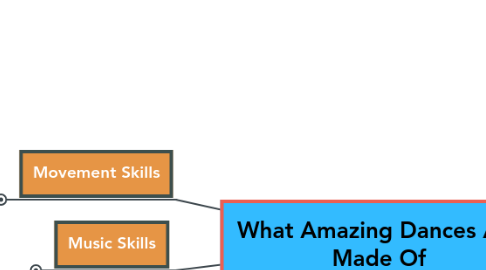
1. Movement Skills
1.1. Movement Strategy: Elastic flow
1.1.1. Movement Tactic: Boing to start every pattern
1.1.1.1. Technique: CASL
1.1.1.1.1. Physical Ability: Body alignment
1.1.1.1.2. Physical Ability: Bicep injury?
1.1.1.2. Technique: Counterbalance
1.1.1.2.1. Physical ability
1.1.1.2.2. Physical ability
1.1.1.3. Technique: Resisted release
1.1.1.3.1. Physical ability
1.1.1.3.2. Physical ability
1.1.2. Movement Tactic: Redirect on time
1.1.2.1. Technique: Use 1,2, or 1/2 beat boing
1.1.2.1.1. Physical ability
1.1.2.1.2. Physical ability
1.1.2.2. Technique: Catch earlier to control bounce
1.1.2.2.1. Physical ability
1.1.2.2.2. Physical ability
1.1.3. Movement Tactic: Lengthen the slot
1.1.3.1. Technique: Continue LOI
1.1.3.1.1. Physical ability
1.1.3.1.2. Physical ability
1.1.3.2. Technique: Leaders' travel triple
1.1.3.2.1. Physical ability
1.1.3.2.2. Physical ability
1.1.3.3. Technique: Floating anchor/ avoid posting
1.1.3.3.1. Physical ability
1.1.3.3.2. Physical ability
1.2. Movement Strategy: taking care of the follower
1.2.1. Movement Tactic: absorbing every redirect
1.2.1.1. Technique: Catch early
1.2.1.1.1. Physical ability
1.2.1.1.2. Physical ability
1.2.1.2. Technique: build connection gradually
1.2.1.2.1. Physical ability
1.2.1.2.2. Physical ability
1.2.1.3. Technique: counterbalance instead of muscle flexion
1.2.1.3.1. Physical ability
1.2.1.3.2. Physical ability
1.2.2. Movement Tactic: prepping safely
1.2.2.1. Technique: Lateral pressure connection
1.2.2.1.1. Physical ability
1.2.2.1.2. Physical ability
1.2.2.2. Technique: rotational spring
1.2.2.2.1. Physical ability
1.2.2.2.2. Physical ability
2. Music Skills
2.1. Musical Strategy: Acknowledge the phrase change with a pose
2.1.1. Musical Tactic: Hear the phrase change coming
2.1.1.1. Music Technique: Listening for chord changes and lyrical poetry
2.1.1.1.1. Acoustic ability
2.1.1.2. Music Technique: Recognizing the formula of the song
2.1.2. Musical Tactic: Control personal timing to be able to stop motion
2.1.2.1. Movement Technique: Delaying or accelerating weight transfer
2.1.2.2. Movement Technique: Choosing appropriate muscles to contract
2.1.2.2.1. Physical ability
2.1.2.3. Movement Technique: Impact or Impulse
2.2. Musical Strategy: Match the song genre & rhythm
2.2.1. Musical Tactic: Dance to contemporary with body pulse
2.2.1.1. Music Technique: How to recognize downbeats and upbeats
2.2.1.1.1. Acoustic ability
2.2.1.2. Music Technique: How to do a back pulse on every beat
2.2.1.2.1. Physical ability: Thoracic spine mobility
2.2.1.3. Music Technique: How to travel and triple while pulsing
2.2.1.3.1. Physical ability: Body Coordination
2.2.2. Musical Tactic: Swing your triples to Swung rhythm
2.2.2.1. Music Technique: Identify the syncopated rhythm
2.2.2.1.1. Acoustic ability
2.2.2.2. Music Technique: Control weight transfer to delay timing
2.2.2.3. Music Technique: How to swing your body shape
3. Pattern & Styling Skills
3.1. Styling Strategy: Look less square at end of slot
3.1.1. Styling Tactic: Avoid flashlighting
3.1.1.1. Movement Technique: Kissing to provide frame engagement in any position
3.1.1.1.1. Physical ability
3.1.1.2. Styling Technique: Allowing over rotation and underrrotation
3.1.1.2.1. Physical ability
3.1.1.3. Styling Technique: Using kiss to decelerate and underrotate ends of turns
3.1.1.3.1. Physical ability
3.1.1.3.2. Physical ability
3.1.2. Styling Tactic: Add anchor syncopations
3.1.2.1. Musical Technique: 2-beat rhythm options
3.1.2.2. Movement Technique: Control over duration of weight transfers
3.1.2.2.1. Physical ability
3.1.2.3. Styling Technique: Suede signatures
3.1.2.3.1. Physical ability
3.1.2.3.2. Physical ability
3.1.2.4. Movement Technique: Contrabody
3.1.2.4.1. Physical ability
3.1.2.4.2. Physical ability
3.2. Pattern Strategy: Present toward audience without stopping
3.2.1. Pattern Tactic: Barrel roll
3.2.1.1. Pattern Technique: Kiss to transition compression to steering
3.2.1.2. Pattern Technique: Maintain balance while modifying pitch
3.2.1.2.1. Physical ability
3.2.1.3. PatternTechnique: Matching pressure and rate of parnter
3.3. Pattern/Styling Strategy: Slingshot to hit an accent
3.3.1. Pattern Tactic: Turning Sugar Push
3.3.1.1. Pattern Technique: Pivoting in compression
3.3.1.2. Pattern Technique: Bowing to separate
3.3.1.3. PatternTechnique: Lateral pressure connection to steer
3.3.2. Pattern Tactic: Accelerate separation into count 3
3.3.2.1. PatternTechnique: Diagonality
3.3.2.2. Pattern Technique: Frame matching
3.3.2.3. Pattern Technique: Bowing
3.3.3. Styling Tactic: Body Roll
3.3.3.1. Styling Technique: Diagonal sheering
3.3.3.1.1. Physical ability: Thoracic spine mobility
3.3.3.2. Styling Technique: Waving of pelvic tilt
3.3.3.2.1. Physical ability: Core activation
3.3.3.3. Styling Technique: Coordinating weight shift
3.3.4. Styling Tactic: Hip Rocks
3.3.4.1. Movement Technique: Split weight position
3.3.4.1.1. Physical ability
3.3.4.2. Musical Technique: Match the rhythm with impact, impulse, or rebound
3.3.4.2.1. Physical ability
3.3.4.3. Styling Technique: Plie lower to get more range of motion
3.3.4.4. Styling Technique: Twist to make figure 8 shape
